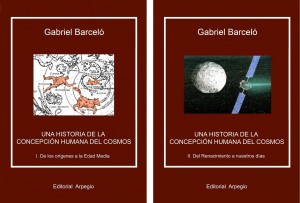 Imago Universi: Historia de la concepción humana del universo, es un apasionante tratado de divulgación científica que describe, de forma fascinante, el afán y la pasión humana por conocer el universo. Incluye además importantes aportaciones personales e innovadoras a la historia de la ciencia.
Imago Universi: Historia de la concepción humana del universo, es un apasionante tratado de divulgación científica que describe, de forma fascinante, el afán y la pasión humana por conocer el universo. Incluye además importantes aportaciones personales e innovadoras a la historia de la ciencia.
Propone el autor la aplicación de la Teoría de Interacciones Dinámicas, a la astrofísica, y en concreto, a la dinámica de los sistemas estelares y las galaxias.
Imago Universi es un tratado en dos tomos:
I – De los orígenes a la Edad Media
II – Del Renacimiento a nuestros días
En cada capítulo de este tratado, el autor analiza la noción del universo que en cada época era aceptada por la comunidad científica. Este análisis permite conocer la lenta evolución del pensamiento humano, dominado en muchos casos, por errores del observador, que originaban ideas absurdas y equivocadas, pero aceptadas en su época.
En el primer volumen, el autor narra los primeros balbuceos, observaciones y preguntas cuyas respuestas, siempre mediatizadas por las diversas creencias religiosas, mostraban una lógica ingenuidad, unida a una evidente sabiduría.
En el segundo volumen, el autor prosigue su análisis desde el Renacimiento hasta nuestros días, se adentra en la ciencia moderna, desde las primeras concepciones heliocéntricas, todavía incipientes, hasta su consolidación, desarrollo y divulgación, haciendo hincapié en las grandes mentes que impulsaron de forma extraordinaria el conocimiento y propiciaron una revolución científica sin precedentes.
Nos encontramos, por ejemplo, con los descubrimientos astronómicos de Galileo Galilei, el inicio del modelo de universo de la edad moderna de la mano de Isaac Newton o la evolución radical de nuestra imagen del cosmos con las teorías de Albert Einstein. Más tarde establece un paralelismo entre el cosmos y el mundo subatómico, dos entornos en los que reinan los sistemas en rotación. Nos describe también las teorías físicas más actuales, los últimos descubrimientos y las exploraciones espaciales, hasta describir la actual concepción científica del cosmos.
Culmina la obra con un último capítulo, en el que propone una nueva, innovadora y sugestiva imagen de un universo en equilibrio dinámico constante, fundamentada en hipótesis dinámicas inéditas, que Barceló sugiere para intentar conseguir una visión más acertada de nuestro universo. El autor-investigador aplica su propuesta de Teoría de Interacciones Dinámicas (TID) para una mejor comprensión del cosmos. Esta teoría permite disponer de nuevas claves para entender la dinámica de nuestro entorno y comprender el equilibrio dinámico del universo, siempre sometido a aceleraciones por rotación. Destaca también el autor que la orbitación, siempre coincide con la rotación intrínseca en los cuerpos celestes. Paradoja que destaca en su libro, pero indicando que este hecho no había sido constatado hasta la fecha.
El autor reclama a la Física más interés en la exploración e investigación de sistemas acelerados no inerciales, y advierte la necesidad de desarrollar programas de investigación científica para su evaluación y análisis, hasta su confirmación, generalización y, en su caso, aplicación de la Teoría de Interacciones Dinámicas en otras muchas áreas de la ciencia y la tecnología.
Este tratado es el fruto de la dedicación y estudio de más de treinta años de trabajo con la colaboración de otros científicos y centros de investigación. El libro constituye una potente herramienta en manos de profesores y alumnos, abriendo amplios campos de interés para quienes sientan inquietudes científicas en el terreno de la cosmología, también representa una contribución asombrosa y fascinante a la historia del conocimiento del universo, aportando una nueva estructura del conocimiento, para mejor comprender los fenómenos cosmológicos.
Para mayor información puede consultare en http://www.editorialarpegio.com/. Ha sido editado junto con un portal propio en Internet: http://imagouniversi.com/, y con un video de presentación que puede consultarse en:http://vimeo.com/62247544
El tratado fue presentado el 30 de mayo de 2013 en la librería Marcial Pons. Adjuntamos ficheros sobre la presentación:
